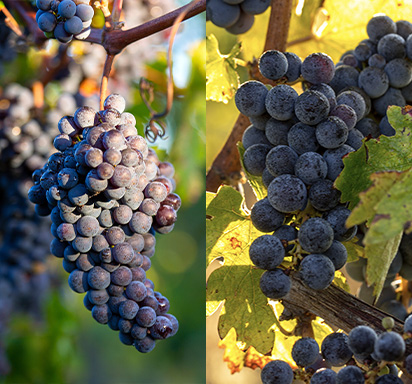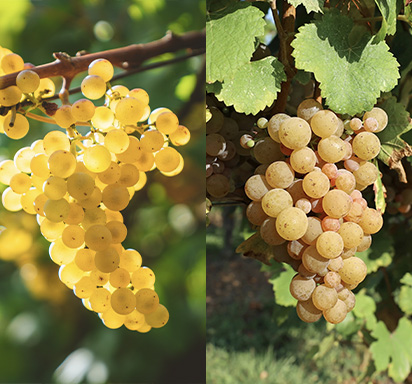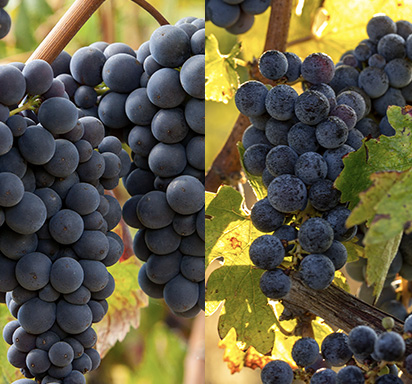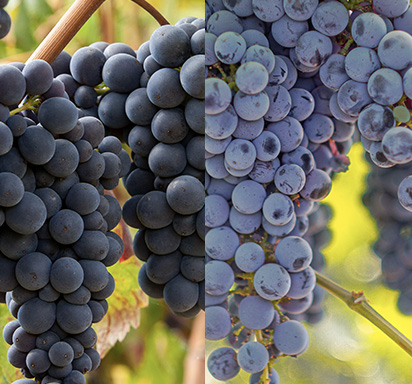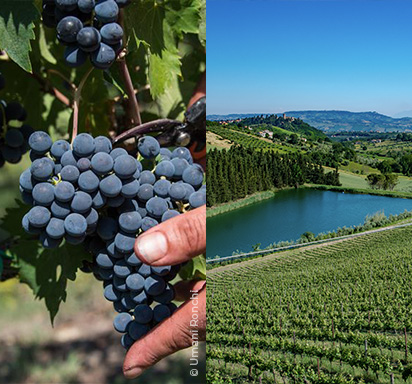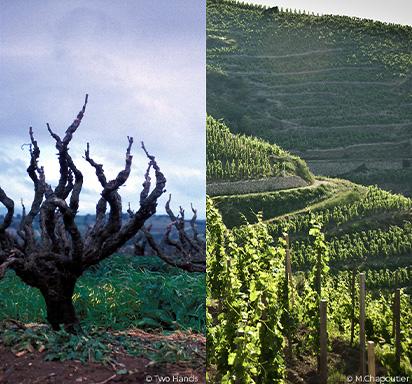Nebbiolo : A grape variety of Excellence
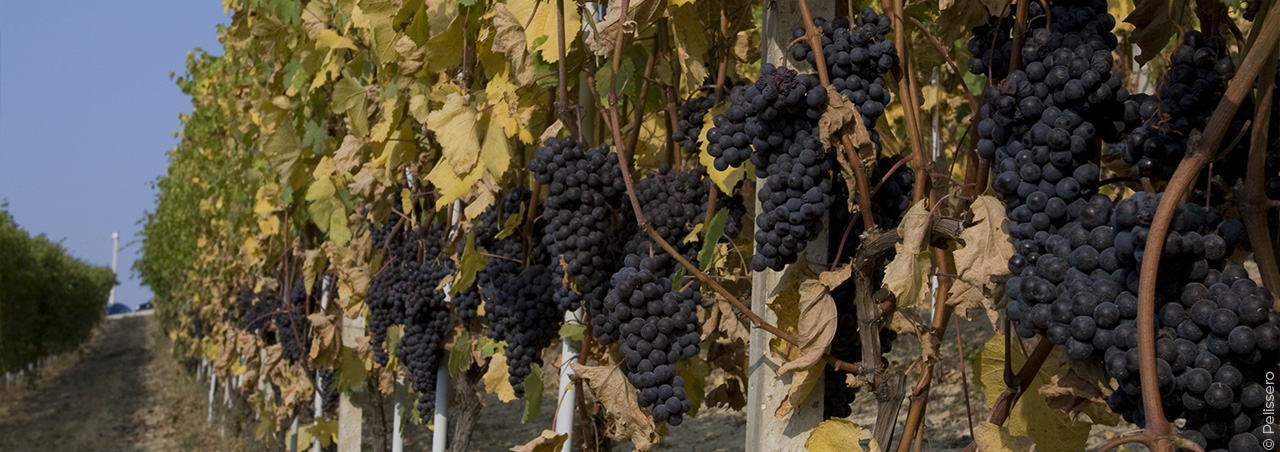
The Nebbiolo grape is considered one of the finest grape varieties in Italy. Its extremely long aging period gives this expressive Italian red wine immense aging potential - much to the delight of collectors of fine wines.
The Nebbiolo grape is widely regarded as one of Italy's most noble grape varieties. Its extremely long ripening period lends an immense aging potential to well-known Italian – much to the delight of fine wine collectors.
History, terroir, aging potential, taste, food pairing tips: Discover everything about the exacting and selective king of Italian grapes!
The History of One of Italy's Oldest Grape Varieties
The noble Nebbiolo grape, known in Italy as the emperor grape, originates from Piedmont in northern Italy. Although its origin is presumed to be in Piedmont, DNA research suggests that Nebbiolo comes from Valtellina, a region in northern Lombardy.
The variety is first explicitly mentioned in 1268, stating that the grape grows in Rivoli. During the Middle Ages, the Nebbiolo variety increasingly gained attention, especially in the region of La Morra. At the same time, Piedmont polished the image of the grape variety. Nebbiolo became a rarity. It took until the 18th century for Nebbiolo to become known beyond Piedmont. The British particularly appreciated the quality of the wine and drew parallels between Nebbiolo and Bordeaux varietals.
The name of the Italian grape variety is linked to the harvest in late autumn October: Nebbiolo is said to be derived from the Italian "nebbia" (fog in English), likely referring to the often-present fog that drifts through the Piedmont hills during the harvest period from mid to late October. Another explanation could be the characteristic white coating that forms on the berries when fully ripe.
A Challenging Grape Variety
Nebbiolo is found almost exclusively in northern Italy – the steep, south or southwest-facing slopes and the calcareous marl soils provide optimal conditions for cultivating and producing this top-quality Italian wine and guarantee its high quality. Nebbiolo is considered a difficult grape variety to cultivate due to its very specific requirements for soil composition and location. Only a terroir that meets these conditions can produce a correspondingly high-quality wine.
Additionally, it is an early-budding vine, which can expose the grapes to late frost or other adverse weather conditions – thus, yields can vary greatly. Not to mention the targeted thinning by vintners, which reduces yields to achieve the best possible quality. All these factors are known to also impact the price of this fine wine.
Where Does Nebbiolo Grow?
When thinking of Nebbiolo, one usually first considers the prestigious wines from Piedmont: Barolo and Barbaresco. However, simpler, fruity Barolo variants are also found on the hills around Alba, including Langhe Nebbiolo and Nebbiolo d’Alba in Piedmont. Additionally, the variety grows in Gattinara in northern Piedmont and, not least, in Valtellina in northern Lombardy.
The Nebbiolo Appellations
The denominations of origin for Nebbiolo, primarily from the hills of Alba and Langhe, focus on local wine-growing areas such as Barolo DOCG, Barbaresco DOCG, Barbera d’Alba DOC.
Within the Nebbiolo d’Alba DOC appellation, clearly overshadowed by the famous Barolo DOCG and Barbaresco DOCG, is the upgraded wine-growing region of Roero DOCG. In all four appellations, Nebbiolo is exclusively grown. To this day, only these appellations are valid for the production of Nebbiolo grape wines and guarantee the quality of production and the exacting methods used in the vines.
Nebbiolo Outside of Italy
While Nebbiolo is now also grown far from Italy, for example in the USA (California, Oregon, Virginia, Washington), in Latin America (Mexico, Argentina, Chile, Uruguay), as well as in Australia and South Africa, the top Nebbiolo wines are still inextricably linked with Italy – because only in its region of origin does this demanding grape variety find ideal conditions, which is why it is almost exclusively found in the famous Piedmont wine-growing areas like Barolo, Langhe, and Alba.
Which wines are made from Nebbiolo?
Barolo and Barbaresco: World-Class Wines from Piedmont
Barolo
The homeland of Barolo wines covers 1500 hectares – equivalent to about 8 million bottles. It spreads over 11 municipalities, which make up 87% of the entire vineyard. Barolo wines are produced in two valleys on clayey, calcareous, and iron-rich soils: Serralunga Valley in the south. Young Barolo wines show a very pale ruby red color, later turning brick red. They have characteristic aromas of roses, violets, tar, red fruits, fennel, tobacco, and cinnamon. As they age, they develop notes of dried flowers, leather, and white truffle. On the palate, they are rich and powerful, with a distinct balance of tannins and acidity.
For those unfamiliar with these wines, they might seem unbalanced in their early youth. However, after a decade in the bottle, Barolo wines show their full potential with a silky texture, pronounced structure, and great aromatic complexity. Find out more on how Barolo wines taste in our article entitled: Tasting Barolo wines: A Comprehensive Guide
Barbaresco
The wine-growing area where the famous Barbaresco wines are produced covers 500 hectares, encompassing three municipalities: Barbaresco, Neive, Treiso, and part of the Alba municipality. This small area allows for some homogeneity of soil, subsoil, and climate. The wines from the Neive municipality, for example, are known to be the most tannic and powerful – those from the Treiso municipality, on the other hand, are considered the lightest and finest. The climate is continental but has a stronger Mediterranean influence due to the proximity of the Tanaro River: an important factor in creating a microclimate. Find out more in our article: From Vineyard to Glass: The Story of Barbaresco Wines
What is a typical Nebbiolo Red Wine?
An Ode to Time
Nebbiolo wines are among the slowest maturing wine varieties in the world – for certain wines, there is even a legally prescribed minimum aging period of three to five years. Accordingly, the aging potential of Nebbiolos is immense. In addition to the demanding cultivation and soil conditions, the latter also naturally impacts the price, which can be significant for a long-aged Barolo or Barbaresco.
Young, more affordable examples tend to have a result dominated by acidity and tannins, although new maceration techniques and aging methods now occasionally produce straightforward, fruity-fresh, absolutely drinkable wines, albeit without the depth and character of long-aged variants.
It is rarely found blended with other grape varieties – but blends with native grape varieties like Vespolina or Bonarda, as well as Merlot or Cabernet Franc, often result in an excellent red wine.
What do Nebbiolo Wines Taste like?
A Garnet Red Wine with Lots of Drinking Pleasure
In the glass, the aged red wine shows its characteristic garnet red. When tasting, complex aromas of blackberries, roses, tar, and licorice unfold. As they age, these primary aromas transform into dried flowers, leather, and truffle. Nebbiolo wines have a firm tannin and acid structure, which is why they need a while to reach optimal drinking maturity, but in return, they have a long aging potential.
What Food Pairs with Nebbiolo?
A Nebbiolo wine pairs perfectly with Italian game dishes and sausage and cheese specialties: A matured Grana Padano is enhanced by a glass of fruity Barbaresco, while a Barolo is often served with Spaghetti al Tartufo. A risotto with mushrooms or white truffles from Piedmont also makes a wonderful pairing: The notes of cherry, wild herbs, and tobacco harmonize beautifully with the earthy flavors of the mushrooms.
You may like
Malbec and Merlot are two beloved red wines, each with unique flavors, tannins,& origins. Malbec offers bold, dark fruit flavors with spice, while Merlot is smoother & more approachable. Learn their differences and food pairings.
4/1/2025Chardonnay and Pinot Grigio are two beloved white wines with distinct flavors. Explore their origins, flavor profiles, body, food pairings, and more to find out which wine suits your taste and occasion best.
3/27/2025Pinot Noir and Merlot are two beloved red wines with distinct flavors, aging potential, and food pairings. Discover their key differences to help you choose the perfect bottle for any occasion.
3/5/2025Pinot Noir vs. Cabernet Sauvignon—two iconic red wines with distinct flavors, body, and food pairings. Learn about their origins, characteristics, and how to choose the perfect bottle for any occasion in this in-depth guide.
3/4/2025Montepulciano refers to both a red grape variety and a wine region. Discover the differences between the bold Montepulciano grape from central Italy and the elegant wines of Tuscany's Montepulciano region.
1/20/2025Syrah and Shiraz are two names for one and the same grape variety, the name of which varies depending on the region and style of the wine. We reveal how the wines differ stylistically - and what unites them.
1/7/2025









